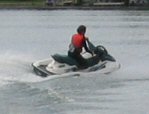Personal Watercraft Defects
High-Speed Fun with High-Speed Defects
 Personal watercraft are vessels operated by a person positioned on the craft. They are less than 4 m in length and use an internal combustion engine to power a water pump or jet as the vessel's primary source of propulsion. The jet exits the rear of the craft from a steerable nozzle.
Personal watercraft are vessels operated by a person positioned on the craft. They are less than 4 m in length and use an internal combustion engine to power a water pump or jet as the vessel's primary source of propulsion. The jet exits the rear of the craft from a steerable nozzle.
Under normal powered operation, a PWC is highly maneuverable. Steering the handlebars directs the water jet at the stern of the craft to give very responsive control. However, consider an emergency situation where a PWC operator realizes a collision with another object is imminent. Many operators instinctively release the throttle and attempt to steer around the impending collision (a logical reaction). Once the throttle on a PWC has been released, the water-jet is essentially shut off. Since the water-jet steers the vessel, all steering control is lost. Little evasive action can be taken to avoid the collision; the PWC continues to travel along its original path. PWCs also require long distances to stop and many have top speeds of over 60 mph (97 km/h). These factors contribute to high collision and injury rates, and have been disastrous for novice operators.
In 1998, the U.S. National Transportation Safety Board (NTSB) released a much-anticipated safety study of PWCs. This study found that they comprise only 7.4% of all registered recreational boats; yet, 51% of all boating accidents involved PWCs, and 41% of all boating injuries involved PWCs. They were clearly overrepresented in the accident statistics for recreational vessels. In addition, PWCs were the only recreational watercraft where the leading cause of death was not drowning but blunt trauma.

For several years, Collision Analysis has been conducting PWC controllability testing and research. Marshal Paulo, founder and past president of Collision Analysis, had testified before the Canadian Government's Standing Senate Committee on Energy, the Environment and Natural Resources on Bill S-10, an act concerning personal watercraft in navigable waters. He presented the controllability concerns and poor operator proficiency issues to the committee.
Mr. Paulo had also been involved with the work of the Society of Automotive Engineers' (SAE) PWC Subcommittee. The subcommittee consisted of manufacturers and North American safety experts for personal watercraft. The subcommittee was attempting to develop a voluntary standard for off-throttle steering performance, and in September 2003, their efforts came to fruition with SAE Recommended Practice J2608 – Off Throttle Steering Capabilities of Personal Watercraft. All PWCs of model year 2006 or newer conform to this standard, but there are still many older craft on the waterways with no off-throttle steering capabilities.
Collision Analysis has assessed the off-throttle turning ability of a variety of PWCs using SAE J2608 as a basis. A course of buoys is set up consisting of an entrance chute and a triangular layout of 6 target buoys that are to be avoided. The PWC operator enters the chute at a specified speed, releases the throttle at the gate marker buoy and turns the steering system at the turn marker buoy. If the PWC avoids entering the region defined by the 6 target buoys, it passes the maneuverability test. The front buoy represents a swimmer, the next 2 represent a dinghy or PWC sized craft and the last three represent a 26 foot boat.

Click here to download video* of several test runs. The runs marked OEM were made with a PWC in stock condition. The runs marked OTS were made with a PWC fitted with an off-throttle steering (OTS) system developed and retrofitted by Collision Analysis.
* The video is in Windows Media format and is 2.12 MB in size.

